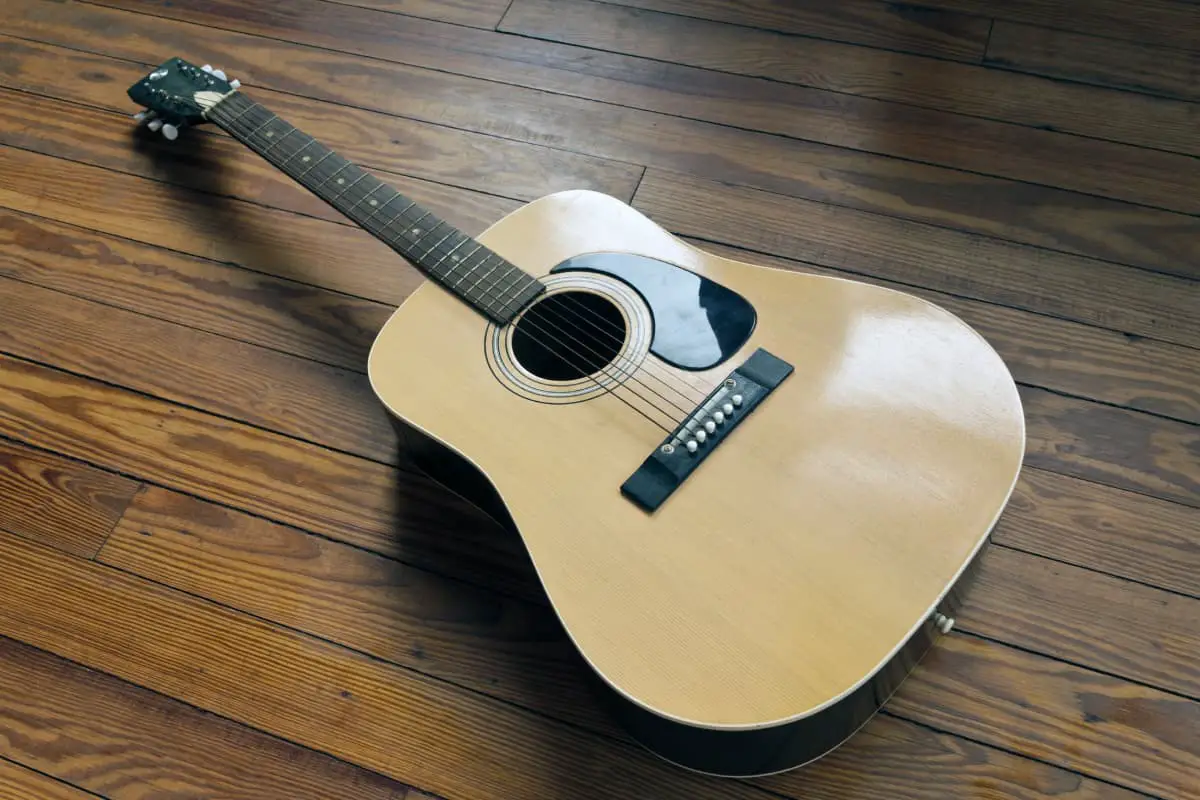We always tacitly accept pickguards as a core part of a guitar, whether acoustic or electric. While we understand their impact on a guitar’s aesthetics, we don’t often question their purpose. Some guitars don’t even have pickguards, so it might be easy to assume that they don’t serve much purpose, particularly on an acoustic guitar.
Acoustic guitars need pickguards as they protect the finish of the guitar from your pick. Pickguards are especially useful if you’re an aggressive strummer. But if you don’t strum hard, you might not need a pickguard. Classical guitars typically don’t need them because you play them with fingers.
In this article, I’ll explain the nitty-gritty of pickguards and what they do on a guitar. You’ll quickly find out whether or not your guitar really needs one.
If you want to find out what my recommended guitar gear is, then here is what I recommend on Amazon:
- Fender Cutaway Acoustic-Electric Guitar Bundle (MY FAVORITE GUITAR)
- Snark SN-8 Super Tight All Instrument Tuner (Easiest Tuner I’ve Used)
- 6 String Acoustic Guitar Capo (Best CAPO for quick changes)
- Dunlop Max Grip 1.0mm Nylon Picks (Thick Guitar Pick So You Don’t Lose Grip!)
- Universal Guitar Stand (Cheap & Minimalist Guitar Stand I Recommend)
- Levy’s 2″ Wide Quick Adjust Guitar Strap (Best Guitar Strap For Any Level)
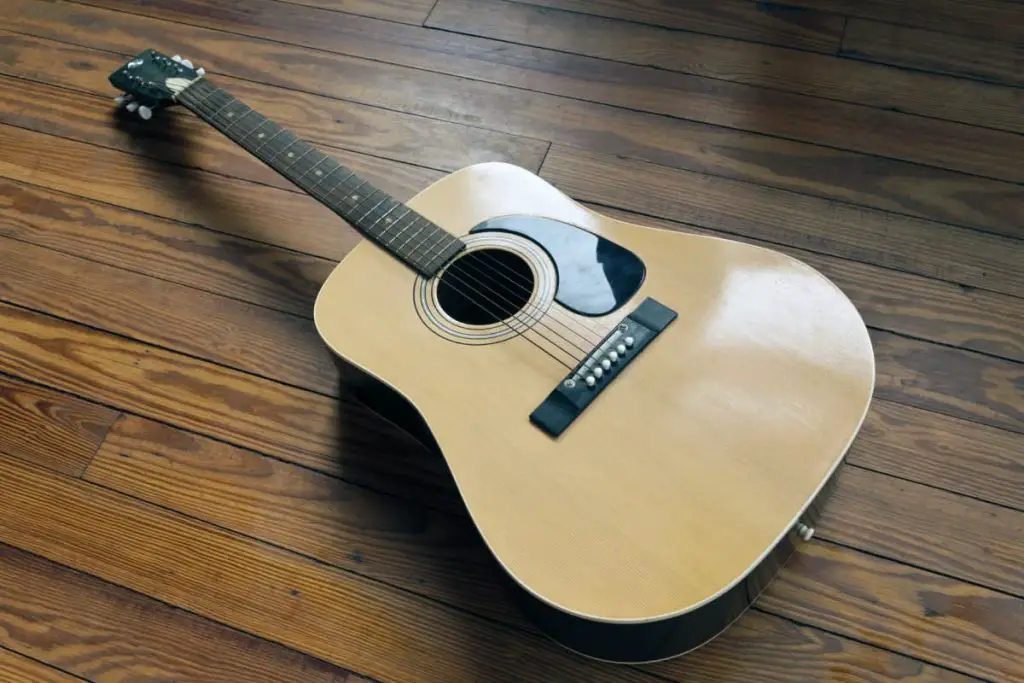
What Is a Pickguard?
A pickguard or scratchplate is a piece of plastic (or other material) that protects your guitar from getting damaged while playing. It also serves a decorative purpose and can be easily customized for the guitarist’s self-expression.
If you play with a pick, particularly if you strum fast and aggressively, your pick will inevitably hit the guitar just below the sound hole.
Even if you’re really careful (and I don’t doubt you are), you’ll still occasionally hit the wood. Over time, this can lead to your guitar being scratched and battered, especially if you play very often.
For that reason, it’s necessary to have a pickguard on your acoustic or electric guitar. The pickguard is made from the same material as the pick, which is plastic, so it can’t be easily damaged by it. Even if it gets scratched, replacing it is easy and cheap.
Another reason for adding a pickguard is aesthetics. For example, many guitars, such as the Stratocaster, have a recognizable design owing in huge part to their pickguards.
Adding an original and unique pickguard to your guitar is a great way to make it stand out and capture the eyes of many potential players.
Pickguards are also occasionally used for autographs. It’s an amazing feeling to play a guitar signed by your favorite guitarist, and you also get some bragging rights in that case. In addition, a signed pickguard can be easily removed and sold as memorabilia for a decent amount of money.
Does an Acoustic Guitar Really Need a Pickguard?
An acoustic guitar needs a pickguard for protection. However, this largely depends on how you play. A pickguard might not be necessary if you play with great accuracy and don’t strum too hard. If you have an aggressive playing style, it’s better to have one.
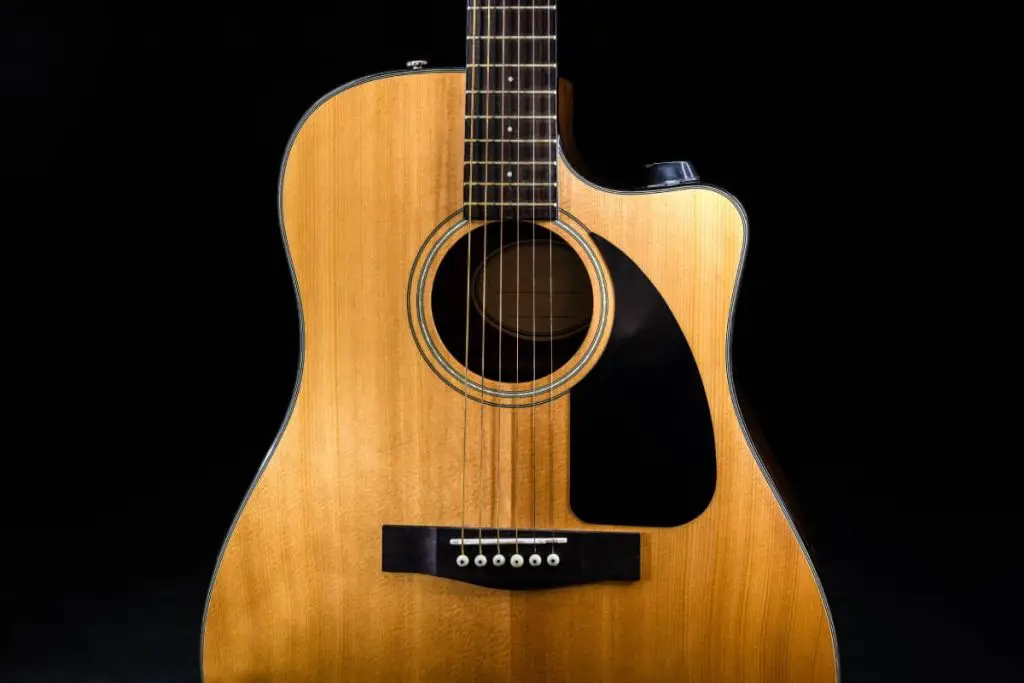
A pickguard on an acoustic guitar has a practical purpose that should not be neglected. It will protect your acoustic guitar from getting scratched, saving you some money in the long run since you won’t have to get it repainted and fixed.
This is especially true if you play fast-paced music and like to go ham on your guitar and strum hard and fast. You probably do, as it’s kind of hard to sit still and play with the utmost care when you get to a particularly catchy passage. You should use a pickguard if you like to go wild and don’t want to see your guitar scratched.
On the other hand, if you prefer slow-paced music and have great control of your strumming hand, then the chances of scratching your guitar with the pick are minimal. In that case, you might do just fine without a pickguard. As a matter of fact, many acoustic guitars come without pickguards installed, probably because you’re expected to play them slowly and calmly.
However, no matter your playing style, it’s best to have a pickguard even if it doesn’t seem necessary. It’s better to be safe than sorry, as the saying goes, and it’s particularly true here. Don’t take any chances, especially if you’ve got a particularly pricey guitar.
Why Are Guitars Scratched Easily?
The wood that guitars are made of should be resonant but light. This lightness makes it easily scratchable because it means that the wood will be relatively soft. Unlike the wood, the pick is made from hard plastic, so it’ll damage the guitar easily.
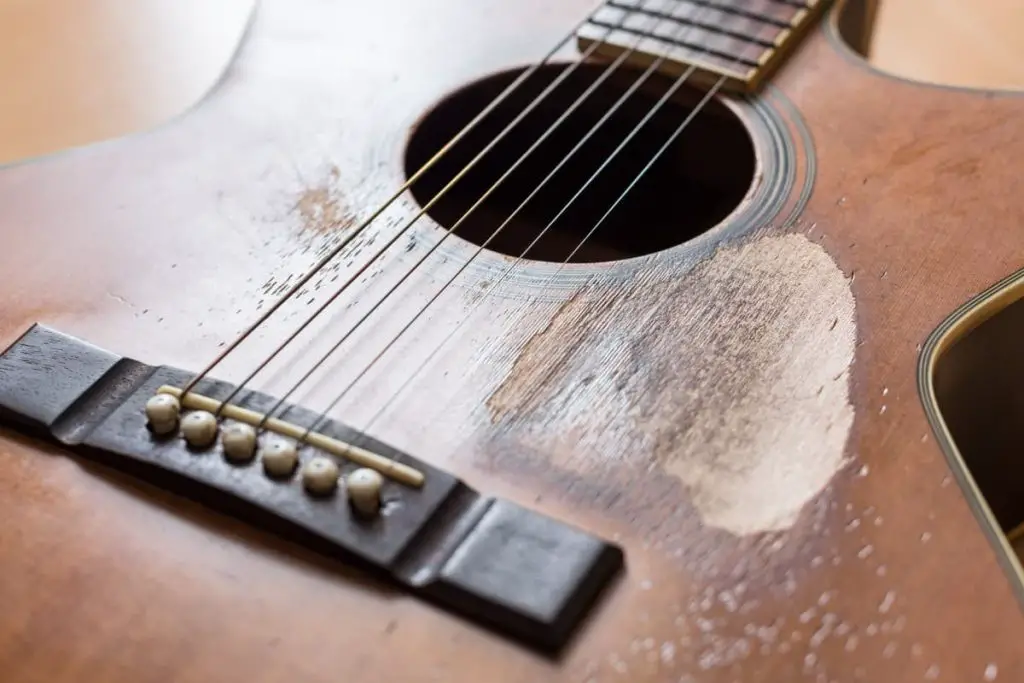
When building a guitar, you need resonant wood. Resonant types of wood are usually lightweight but strong, such as spruce. These qualities, unfortunately, make it more easily scratchable, unlike, for example, maple.
Sadly, tough, durable wood like maple is not resonant enough for an acoustic guitar. This means that manufacturers have to stick to less tough wood to preserve the resonance of their guitars. We can choose between resonance and durability, and resonance is much more important when making an acoustic guitar.
Pickguards are typically made from plastic, just like picks. This prevents picks from scratches or significant damages, which makes pickguards a great way to protect your acoustic guitar from pick-induced damage.
Classical Guitars
You may have noticed that classical guitars typically don’t have pickguards. While there are some exceptions, most classical guitars generally don’t have pickguards. This is because pickguards are simply not necessary on a classical guitar.
Unlike an acoustic guitar, a classical guitar is almost exclusively played with fingers. The flesh on your fingers is soft, so it won’t damage the guitar even if you somehow hit it when strumming. Even a guitarist with long fingernails won’t be able to damage a classical guitar.
In addition to that, classical guitar playing doesn’t require fast, aggressive strumming. Most of the time, it’s relatively slow-paced and calm. This playing style lowers the chances of the guitar getting scratched even further.
Flamenco Guitars
Unlike classical guitars, flamenco guitars have a special kind of pickguard called the golpeador. This may seem unusual because the flamenco guitar is also played with fingers. However, the style is much more fast-paced and aggressive than using a classical guitar, so some protection is necessary.
In flamenco, there is a lot of aggressive, passionate strumming, and a lot of percussive strumming, so a golpeador is necessary to protect the guitar. Some would say that it is not a pickguard as such, but it serves a similar purpose, so we can include it under the umbrella.
In fact, flamenco guitarists seem to be the first to adopt a pickguard in the 19th century. The style was later copied by other guitarists until the first real pickguard was patented by Gibson in 1909. Since then, pickguards have been an indispensable part of the guitar.
Does a Pickguard Affect the Tone of an Acoustic Guitar?
A pickguard won’t affect an acoustic guitar’s tone, at least not significantly. There might be some slight changes, but they are barely audible, and only the finest ears will hear them. Pickguards might have more impact on classical guitars.
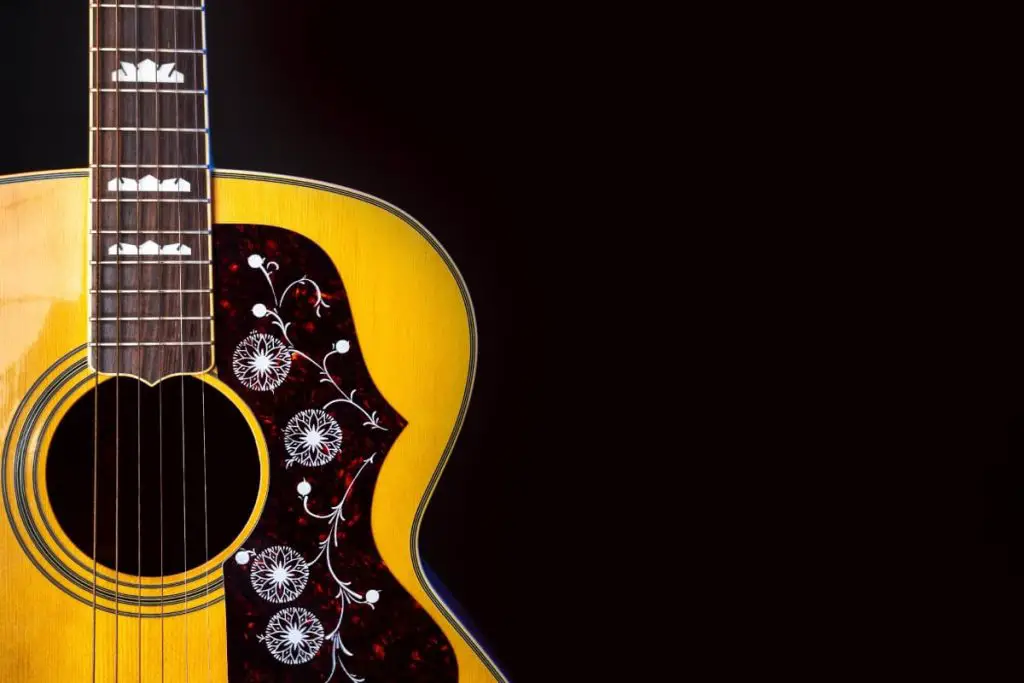
When it comes to typical steel-string acoustic guitars, pickguards won’t have much of an influence, if any. While, theoretically, an acoustic guitar can sound slightly different with a pickguard on, it’s doubtful whether anyone could even hear the difference.
Pickguards are usually made from plastic, as we’ve said, and plastic is far less resonant than wood. In theory, this should dampen the sound a little bit. However, since the pickguard is very small compared to the rest of the guitar, and it’s also very thin, it won’t have much of an audible effect.
Additionally, an acoustic guitar’s back and sides are much more important regarding resonance than the front part. Unless your ears are really finely tuned, you won’t hear a difference.
The difference might be bigger on classical guitars. Since these guitars typically have nylon strings, they don’t have to withstand as much pressure as steel-string guitars, so the wood they’re made of is slightly thinner. Because of that, the pickguard might play a more significant role in dampening the sound.
Even so, the difference might not be particularly audible. All in all, there is no need to worry about a pickguard altering the sound of your guitar. Even if there is a difference theoretically, it probably won’t be audible.
Electric Guitars
When it comes to electric guitars, the question of how much a pickguard influences the tone is a bit more complex. Generally speaking, it has an even smaller influence compared to acoustic and classical guitars.
Most of the time, it won’t influence the sound at all because an electric guitar produces sounds when the strings interact with the magnetic field of the pickups. These signals are transmitted to the amp, where they are amplified until they’re audible.
In other words, the guitar’s electronics are responsible for creating the sound. This doesn’t create a mechanism through which a pickguard can influence the sound in any way. It’s even debatable whether the wood has any influence over the sound of an electric guitar, with many experts saying that it doesn’t.
However, there are some electric guitars on which the pickguard is a much more crucial component. For example, on Strat-style guitars, the pickguards cover the circuitry inside the guitar. If you removed the pickguard, there would probably be changes to the sound because the sensitive wiring would be out in the open.
The material of the pickguard can also play a role in the sound. Metal pickguards can interact with the pickups, influencing the sound. Some say this is responsible for the sound of Telecaster and Zemaitis guitars. In such cases, removing or changing the pickguard will influence the sound, at least to some extent.
Other Uses of a Pickguard
We’ve covered the main reasons why your guitar needs a pickup. However, the list doesn’t stop there, as there are some other uses of a pickguard that might not be perfectly obvious, but it’s good to know about them.
Let’s examine these other uses in greater detail.
Customizability
Pickguards add a degree of customizability to your guitar. It’s another way in which you can influence the cosmetics of your guitar and tweak it to make it more to your liking and express yourself.
The good thing with pickguards is they’re easily and cheaply replaceable, and the changes are reversible, so tinkering with them won’t cause any damage to your guitar. On the other hand, it might look much better and more stylish, making it a better fit for your image.
Pickguards come in many different sizes, shapes, and materials, so there’s practically no limit to the customizations you can pull off. You can even get high-end, luxury pickguards for additional cool points and an increase in the value of your guitar.
Brand Identity
The pickguard can play an important role in the recognizability of a guitar and the guitar brand. It’s often an essential part of its design, and some guitar models are recognizable in great part due to their pickguard shapes. We’ve already mentioned Strats and Teles, but the Gibson SG is another important example with its unique pickguard shape.
Apart from cosmetics, a pickguard plays an important role in how some guitars are constructed. To go back to the example of the Stratocaster, we’ve mentioned that on a Strat, the pickguard covers the circuitry inside the guitar. This enabled the manufacturer to produce the circuitry separately and simply install it in the guitar and cover it with the pickguard, driving production costs down.
Just like a pickguard can be an important part of your self-expression, it can also be an important part of a manufacturer’s self-expression. Aesthetics are a huge part of guitar design, and pickguards are a key component regarding that. We all remember the shapes of popular guitars, and manufacturers don’t forget that.
Electrical Interference
As mentioned before, a metal pickguard may interfere with the magnetic field of the pickups and influence the sound. Sometimes, that can be used to the advantage of the guitar, but sometimes, it can be a problem. In that case, opting for plastic (or some other non-metal) will be a good choice.
Can You Remove or Change the Pickguard?
You can change and remove your pickguard. It’s usually not difficult to do, especially on an acoustic guitar. However, if you’ve got a high-end guitar, it’s best to let a luthier or a guitar technician deal with it.
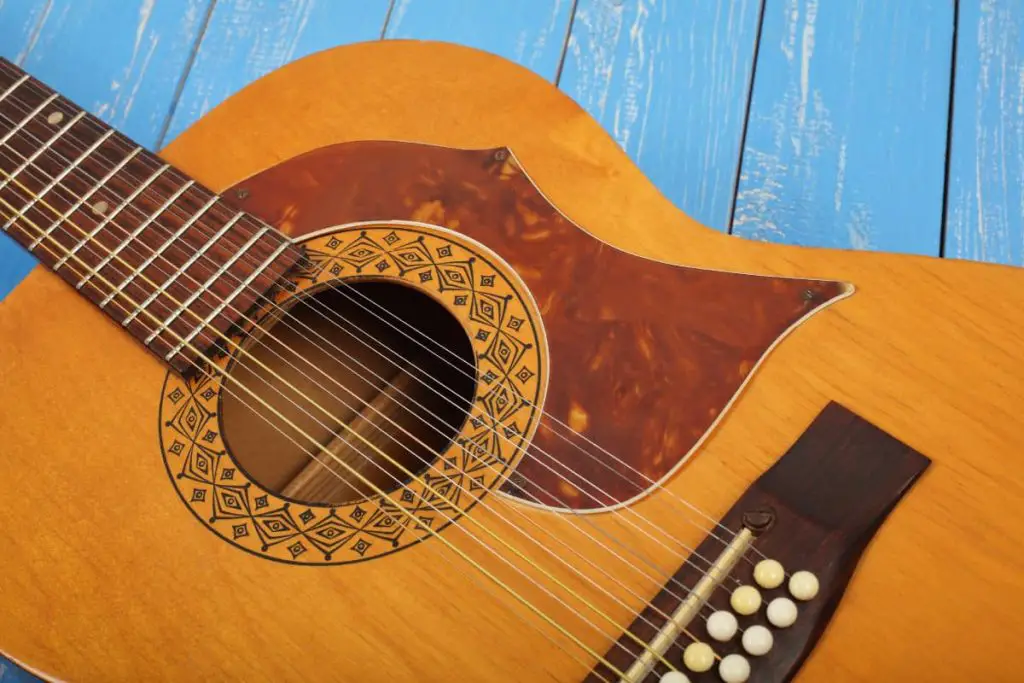
Changing and removing pickguards is not a particularly difficult task. It’s best to do it when you change your strings, as you’ll have to uninstall them to remove the pickguard anyway, so you can just kill two birds with one stone.
Let’s see what you can do if you don’t want your guitar to have a pickguard.
Acoustic Guitar
To remove it from an acoustic guitar, you’ll have to remove the glue. Some recommend that you do this with a hairdryer. You should set it to light warmth and point it at the pickguard for a minute or two. This should loosen the glue and allow you to remove the pickguard and install a new one.
Be careful not to overdo this because the heat can cause the glue on the other parts of the guitar to deteriorate, so you might end up with a guitar in pieces. Since you’re not aiming to get an IKEA guitar, you should tread with care.
If you’re not confident in your skills or if you have a guitar of great value (be it sentimental or monetary), find a luthier or a guitar technician. You’ll have to pay, so it will be a bit expensive, but you’ll be sure that nothing will go wrong. So unless you’re sure of your skills, it might generally be better to leave such tasks to the professionals.
If you only wish to remove the pickguard without installing a new one, keep in mind that the part below the pickguard will be of a different color than the rest of the guitar. This is because it gets almost no exposure to UV rays and other factors that cause the guitar wood to discolor and get darker.
If you dislike how your guitar looks with a pickguard, remove it while it is still new. Otherwise, you’ll get a discolored patch that won’t look at all.
Electric Guitars
On many electric guitars, the process will be a lot more complicated. You’ll have to remove the tone and volume knobs, as well as pickups. You have to remove even the bridge on some guitars, like the Fender Jazzmaster.
If you’re lucky enough to have a Telecaster, then you only have to remove the strings and unscrew the pickguard. But, chances are, you have a different guitar, so you’ll have to deal with much more than that.
We’d advise that you get a professional to do this unless you’re very experienced and confident in your skills. At the very least, find a friend who’s knowledgeable about guitars and willing to help you. You don’t want to wreck your guitar, especially if it’s a high-end one.
Conclusion
Pickguards play an important role in protecting your guitar from scratches. You shouldn’t remove one unless you’re certain you won’t scratch or damage it. Pickguards are also important for aesthetics and self-expression.
If you want to find out what my recommended guitar gear is, then here is what I recommend on Amazon:
- Fender Cutaway Acoustic-Electric Guitar Bundle (MY FAVORITE GUITAR)
- Snark SN-8 Super Tight All Instrument Tuner (Easiest Tuner I’ve Used)
- 6 String Acoustic Guitar Capo (Best CAPO for quick changes)
- Dunlop Max Grip 1.0mm Nylon Picks (Thick Guitar Pick So You Don’t Lose Grip!)
- Universal Guitar Stand (Cheap & Minimalist Guitar Stand I Recommend)
- Levy’s 2″ Wide Quick Adjust Guitar Strap (Best Guitar Strap For Any Level)
Related Posts:

